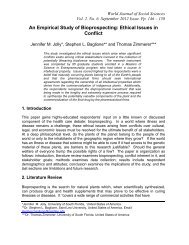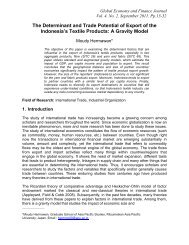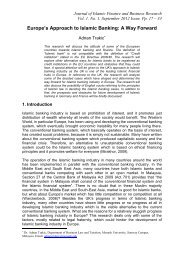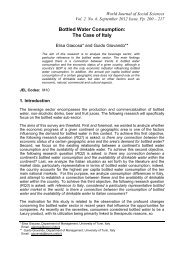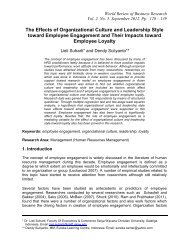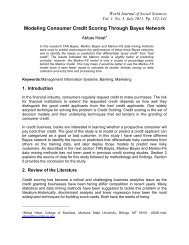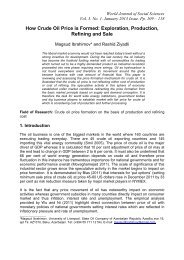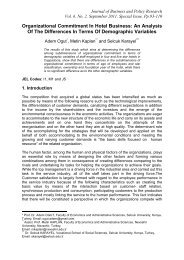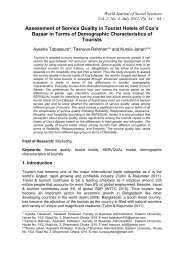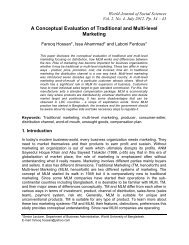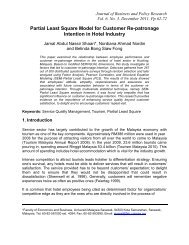Consequences and causes of inflation: A study in the ... - Wbiaus.org
Consequences and causes of inflation: A study in the ... - Wbiaus.org
Consequences and causes of inflation: A study in the ... - Wbiaus.org
You also want an ePaper? Increase the reach of your titles
YUMPU automatically turns print PDFs into web optimized ePapers that Google loves.
Abdullah, Shamsher & Chowdhury(1997) <strong>in</strong>volv<strong>in</strong>g 70 countries (<strong>of</strong> which 48 are develop<strong>in</strong>g economies) for <strong>the</strong> period1960-1989 found no causal relationship between <strong><strong>in</strong>flation</strong> <strong>and</strong> economic growth <strong>in</strong> 40per cent <strong>of</strong> <strong>the</strong> countries; <strong>the</strong>y reported bidirectional causality <strong>in</strong> about 20 per cent <strong>of</strong>countries <strong>and</strong> a unidirectional (ei<strong>the</strong>r <strong><strong>in</strong>flation</strong> to growth or vice versa) relationship <strong>in</strong> <strong>the</strong>rest. More <strong>in</strong>terest<strong>in</strong>gly, <strong>the</strong> relationship was found to be positive <strong>in</strong> some cases, butnegative <strong>in</strong> o<strong>the</strong>rs. Recent cross-country studies <strong>of</strong> Fischer (1993), Barro (1996) <strong>and</strong>Bruno <strong>and</strong> Easterly (1998) show that <strong><strong>in</strong>flation</strong> affect<strong>in</strong>g economic growth negatively<strong>in</strong>clude. Fischer (1993) <strong>and</strong> Barro (1996) found a very small negative impact <strong>of</strong> <strong><strong>in</strong>flation</strong>on growth. Yet Fischer (1993) concluded “however weak <strong>the</strong> evidence, one strongconclusion can be drawn: <strong><strong>in</strong>flation</strong> is not good for longer-term growth”. Barro (1996) alsopreferred price stability because he believed it to be good for economic growth.Bruno <strong>and</strong> Easterly‟s (1998) work is <strong>in</strong>terest<strong>in</strong>g for not<strong>in</strong>g that <strong>the</strong> ratio <strong>of</strong> people whobelieve <strong><strong>in</strong>flation</strong> is harmful to economic growth to tangible evidence is unusually high.Their <strong>in</strong>vestigation confirms <strong>the</strong> observation <strong>of</strong> Dornbusch (1993), Dornbusch <strong>and</strong>Reynoso (1989), Lev<strong>in</strong>e <strong>and</strong> Renelt (1992) <strong>and</strong> Lev<strong>in</strong>e <strong>and</strong> Zervos (1993) that <strong>the</strong><strong><strong>in</strong>flation</strong>-economic growth relationship is <strong>in</strong>fluenced by countries with extreme values(ei<strong>the</strong>r very high or very low <strong><strong>in</strong>flation</strong>). Thus, Bruno <strong>and</strong> Easterly (1998) exam<strong>in</strong>ed onlycases <strong>of</strong> discrete high-<strong><strong>in</strong>flation</strong> (40 per cent <strong>and</strong> above) crises <strong>and</strong> found a robustempirical result that growth falls sharply dur<strong>in</strong>g high-<strong><strong>in</strong>flation</strong> crises, <strong>the</strong>n recoversrapidly <strong>and</strong> strongly after <strong><strong>in</strong>flation</strong> falls.Although many cross-sectional studies have been carried out to establish <strong>the</strong> exactrelationship between growth <strong>and</strong> <strong><strong>in</strong>flation</strong>, very few studies have been conducted forBangladesh. Malik <strong>and</strong> Chowdhury (2001) exam<strong>in</strong>ed <strong>the</strong> <strong><strong>in</strong>flation</strong>-growth relationship forfour South Asian countries (Bangladesh, India, Pakistan <strong>and</strong> Sri Lanka) for <strong>the</strong> period1974–97. They found a positive relation between <strong><strong>in</strong>flation</strong> <strong>and</strong> growth rates with nostructural break for <strong>the</strong> four countries. On <strong>the</strong> o<strong>the</strong>r h<strong>and</strong>, Burdek<strong>in</strong> et al. (2000), <strong>and</strong>Judson <strong>and</strong> Orphanides (1999) have estimated a non-l<strong>in</strong>ear relationship <strong>and</strong> discoveredstructural breaks for many develop<strong>in</strong>g countries <strong>in</strong>clud<strong>in</strong>g Bangladesh. These variedf<strong>in</strong>d<strong>in</strong>gs, <strong>the</strong>refore, deserve fur<strong>the</strong>r <strong>in</strong>vestigation for policy implications. Besides, it isargued that an <strong>in</strong>dividual country <strong>study</strong> should provide more reliable estimates thancross-country studies as country-specific relevant variables can be controlled properly<strong>and</strong> homogeneity can also be ma<strong>in</strong>ta<strong>in</strong>ed. Different dem<strong>and</strong> <strong>and</strong> supply responses forpolicy changes <strong>in</strong> different countries might result <strong>in</strong> different economic outcomes <strong>and</strong>provide mislead<strong>in</strong>g results under cross-sectional data. Temple (2000) po<strong>in</strong>ted out that <strong>in</strong>cross-country studies compris<strong>in</strong>g relatively dissimilar develop<strong>in</strong>g countries, <strong><strong>in</strong>flation</strong>aryimpacts might differ <strong>and</strong> <strong>the</strong>refore, extrapolation requires more caution. He fur<strong>the</strong>rargued, cit<strong>in</strong>g f<strong>in</strong>d<strong>in</strong>gs <strong>of</strong> several studies that <strong>the</strong> detection <strong>and</strong> significance <strong>of</strong> somerelationships change when cross-section <strong>in</strong>stead <strong>of</strong> annual panel data is used or if <strong>the</strong>time-horizon is altered. Bangladesh is under pressure from <strong>the</strong> <strong>in</strong>ternational lend<strong>in</strong>gagencies (IMF, <strong>the</strong> World Bank <strong>and</strong> ADB) to reduce its <strong><strong>in</strong>flation</strong> rates <strong>in</strong> order to boosteconomic growth.Two recent works (Bruno <strong>and</strong> Easterly, 1998 <strong>and</strong> Paul, Kearney <strong>and</strong> Chowdhury, 1997)do not shed much light on what is <strong>the</strong> right approach. Their f<strong>in</strong>d<strong>in</strong>gs appear counter<strong>in</strong>tuitiveas <strong>the</strong> four South Asian countries share a very similar economic structure <strong>and</strong>until very recently have followed (<strong>and</strong> are still follow<strong>in</strong>g) roughly similar economicpolicies (e.g., a relatively large public sector, a nationalized f<strong>in</strong>ancial sector <strong>and</strong> fiveyearplans though with vary<strong>in</strong>g emphasis). It is possible that <strong>the</strong> counter-<strong>in</strong>tuitive results<strong>of</strong> Paul, Kearney <strong>and</strong> Chowdhury (1997) are due to methodological deficiencies. Forexample, Paul, Kearney <strong>and</strong> Chowdhury (1997) used <strong>the</strong> Dickey-Fuller (DF) <strong>and</strong>92



